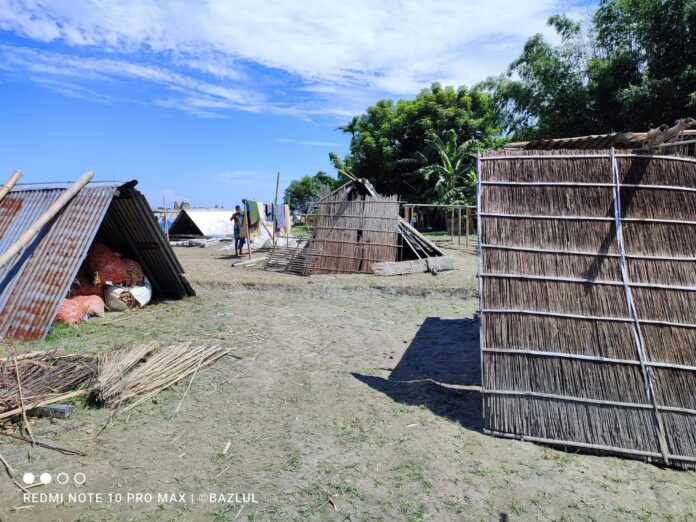
Abdur Rahman Aman
GUWAHATI—The Assam government has promised to provide 1000 bighas of land to resettle Muslims evicted from Dholpur 1, 2, and 3 villages.
But the land to be allotted to resettled the evicted Muslims is located in the bed of an old stream of the river Brahmaputra and remains inundated for more than four months in a year.
The proposed land remains submerged under four to five feet and sometimes 10 to 12 feet during monsoon.
The villages where they were earlier living were located between Na-Suti and Mara Suti rivers, just a few kilometers from Sipajhar town.
No power supply, no motorable road to reach the proposed resettlement site
And the new place where over 900 Muslim families have been forced to shift is several kilometres away from Sipajhar town, with no electricity and no all-weather connecting road. There is no motorable road connecting the new place. One has to travel on foot for four to five kilometers or ride a motorcycle, a luxury that is not available to many of the extremely poor Muslims.
Currently, the evicted Muslim families have temporarily settled down on a river sandbar where they have erected sheds without any government help.
The Muslims from Dholpur 1, 2, and 3 villages were evicted from their homes on September 20 and 23.
The land where the Muslims were settled was the government land. But there are many other communities also who are living on government land with no title deeds in their names. But they are not Muslims. Those evicted from Dholpur are Bengali-speaking Muslims, and the state government considers them as “illegal immigrants”.
The government has got the Dholpur land vacated for carrying out agricultural activities. The government has got cleared 27,000 bighas of land from the Bengali-speaking Muslims of the Dholpur cluster.
A victim of the eviction drive, Osman Ali, said, “The state government has thrown us away as if we are useless material.”
“We have been made a scapegoat of communal agenda of BJP and RSS,” he alleges.
Abdul Karim of Dholpur 2 said, “The government has kept us as prisoners in such a wetland where there is no road linking with other places.”
“All the outgoing paths have already been blocked by the people involved with the proposed agricultural project with the help of police administration, and whole evicted areas have been brought under cultivation,” Karim added.
The state government has promised to allot one bigha of land to each of the evicted families for construction of houses and agricultural purposes as all the evicted families are cultivators and depend on agriculture to eke out their living. However, many evicted persons are not sure if the government would keep its promise because of their bitter experience in the past with the government.
“How we can believe the verbal promise of the government that has ruined us completely within hours”, said Khadija Begum of Dholpur 1.
Khadija Begum said, “We are staying in makeshift camps in inhuman conditions. We have been deprived of all basic amenities like drinking water, toilets, etc. Our children and elders are suffering from various diseases, but there are medical facilities available.”
A leader of the All Assam Minority Students Union (AAMSU) said that 1,000 bighas of the land promised for the evicted families was not sufficient for more than 1,000 evicted families because the evicted people are cultivators. They require land for building homes and also for cultivation.
Mohammad Ali Khalifa, president of Assam Sankhyalaghu Sangram Parishad (ASSP), an organization fighting for the rights of Muslims and other minorities, told media persons that the district administration had mobilized more than 1500 policemen, apart from CRPF personnel, to evict Muslims from Dholpur villages.
Evictions indicate anti-Muslim sentiments
Assam-based human rights lawyer Tania Laskar told media persons that evictions indicated anti-Muslim sentiments. He said that the media under the control of people peddling anti-Muslim sentiments support the government’s narrative. And anybody who comes in defence of the victims is penalized with cases against them. Hence, it becomes tough for the religious and linguistic minorities to fight in such a situation. And it is really a big thing that religious minorities are fighting for their rights even in such an atmosphere.
The Decision to remove Muslims was taken on June 5
The decision to remove “encroachments” from government land or what could be called to remove Bengali-speaking Muslims was taken at a cabinet meeting on June 5. The decision was taken to remove people from 77,000 bighas of land in the area and start an agriculture cultivation program over the land.
The eviction programme began soon after. On June 6, 70 Muslim houses were removed from the Kaki area by the Hojai district administration. On June 7, 49 Muslim families were evicted from Dholpur 1 on the pretext that they had occupied the land where a Shiv Temple stood once.
In June end, 200 Muslim families were evicted in the Patharkandi area in the Karimganj district. Earlier on May 17, 25 Muslim families were evicted from the Jamugurihat area in Sonitpur district.




